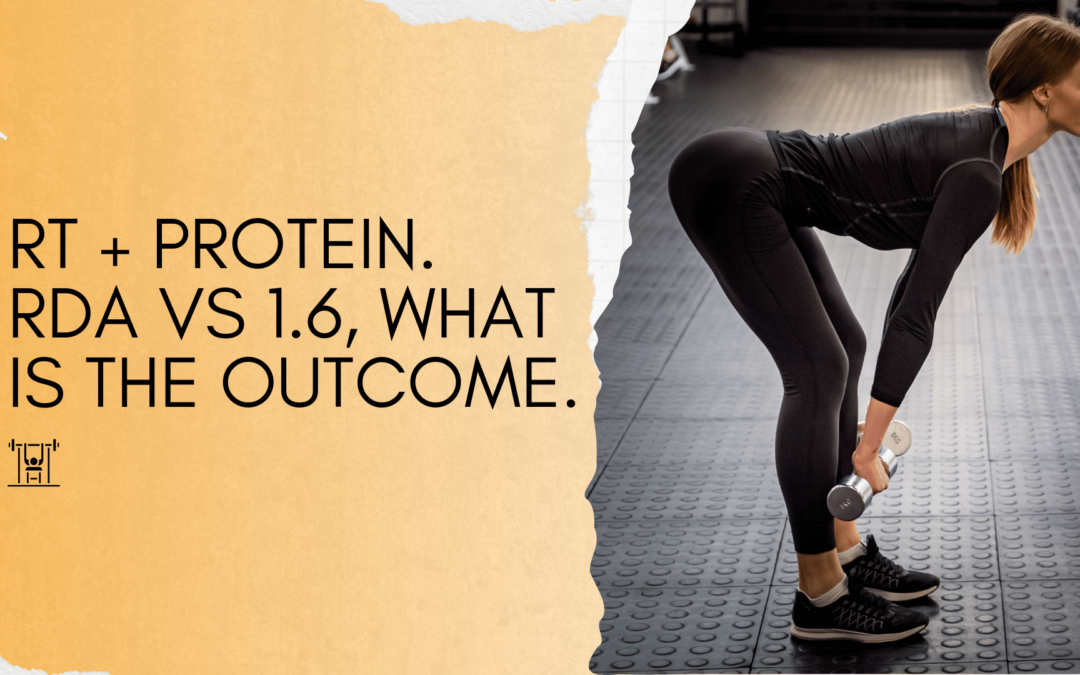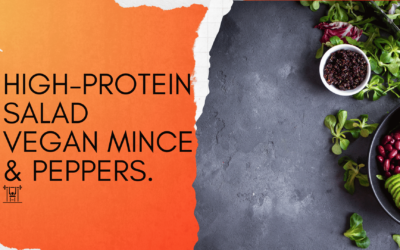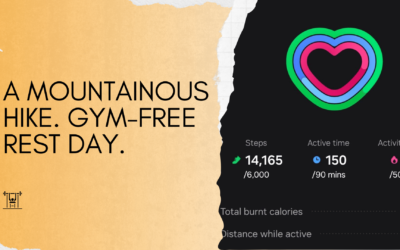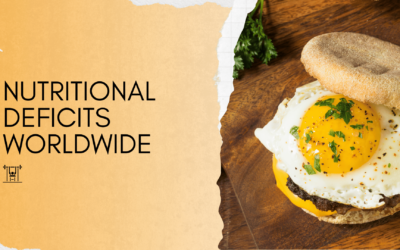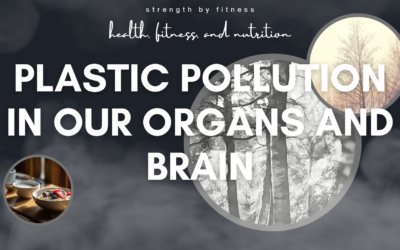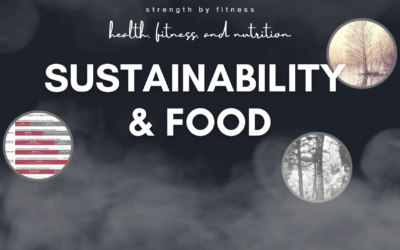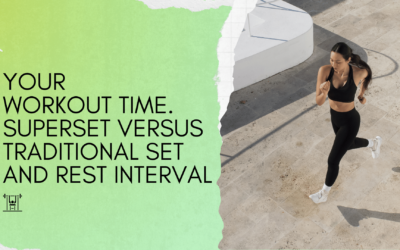
Strength By Fitness
Daily Protein Intake. RDA ( 0.8G ) Protein Per Day & Kg Of Bodyweight, VS 1.6+ and the outcome of Lifting Weights.
Yet, another fact-based article from Strength by Fitness.
This is not the first time we have talked about protein at Strength By Fitness. But why should it be, protein is not only an essential nutrient with a huge impact on human health, healthy aging, and development. It carries with it an immense fact-based impact on people’s fitness progression too.
As I recently discussed in another article, protein should without a doubt be the no.1 food pillar for most people around the world.
Not to mention that, like with so many other things that relate to our health & fitness progression the scientific layers of protein consumption & the consequential benefits of that protein consumption are multi-layered and complex.
So there are good reasons to continue the fact-based conversation about protein.
In today’s article, I will keep it really simple and solely talk about the actual real-life difference between resistance training people who on the one hand, are consuming 0.8 grams of protein per kilo of body weight & day, which is the recommended daily protein intake to sustain the absolute minimum of health, and biological functions in your body.
While, in the other group we had omnivore participants that consumed 1.6 grams of protein per day and kilo of body weight. What they did in this study was to compare how this difference in protein consumption relates to fact-based strength training, lean muscle mass progression and our health.
The study I will reference in this article only lasted 8 weeks, which is a pity. But it is what it is, and to be fair, it can be very hard to track & impose a strict food intake, and exercise program on a group of people for a longer period of time.
That caveat ( only 8 weeks ) does not really matter, however, because the progression and benefit of lifting weights & eating in a fact-based way will never come to an abrupt halt.
It is an endless cycle that repeats every single day for the rest of your life, as long as you maintain high-protein food habits & your weekly resistance training.
So, there are no good scientific reasons for assuming that the fact-based difference between 0.8 and 1.6 g of protein would ever cease to exist, not even after 5, 10, or 20 years of eating healthy foods and going to the gym.
It’s quite the opposite and this article will make that pretty clear too. The longer you train, and the older you become, the more important those gym & high-protein habits becomes, relatively speaking.
Yes, of course, the rate of progression drops over time, the more advanced and fit we become, the slower it becomes to improve even more. Add to this the onslaught of time as we age, and all of a sudden hypertrophy and nutritional absorption & processing are all a little less effective ( thus making healthy high-protein food habits even more important ).
But, the thing with progression is that it does not come to a permanent stop, it just slows down.
Progression slows down, but it does not ever stop permanently,
For instance, men and women can build strength and muscle mass well into their 80s, and the importance of doing so only increases with age.
To make it short & sweet for you, here is a quote from the study in question if you wish to skip the rest of my article.
A daily intake of 1.6 g/kg/d protein was superior to 0.8 g/kg/d ( recommended daily intake for maintaining basic health & functions ) for promoting greater improvements in skeletal muscle mass and muscle strength.
Now, that quote will not come as a surprise to anyone who is keeping up with the fabulous world of science-based health, nutrition, and fitness. The health and fitness benefits of eating more protein per day than the recommended daily allowance have been well documented over the years in way more studies than I care to count.
But, I originally wrote this article a couple of years ago before giving it a slight update today because we are living in a strange time & world where unscientific health, food, and fitness advice is seemingly finding life and room all over the place. So this short & simple study is a good, fact-based reminder for a lot of people out there that there are very clear health & fitness benefits that a higher daily protein intake will create for you.
What´s that you say? You have a question? Yes, because I thought that people ate too much in general.
Yes, you are absolutely right.
The general population in affluent, well-developed nations and communities certainly eats too many calories and junk food in total.
And that is one important aspect of a healthier lifestyle that a lot of people need to change. Not only is an excess amount of calories a bad long-term prospect for our health, but lower quality foods and poor nutritional intake lead to health issues all on their own even if the total amount of calories is in balance.
However, overconsumption of calories and lower-quality foods does not change the clear health and fitness benefits of consuming more protein than the recommended daily allowance.
It makes the importance of high-protein food plans even bigger due to how higher-protein intake tracks with increased satiety, better nutritional consumption and better body composition and health outcomes.

RDA is simply put what you need to sustain basic functions and health in body and mind. So this is a lower intake level that you should never dip below.
Combining a higher protein intake than the RDA with a healthy total nutritional intake that is in balance with our energy expenditure is a fundamental pillar of a much healthier and fitter lifestyle.
RDA is simply put what you need to eat to sustain basic functions and health in body and mind. So this is a good recommendation no matter the nutrient, that no one should ever dip below.
But when we talk about human health & life, why stop at the lowest barrier?
Health & fitness is not just about meeting your RDA on one hand or becoming obese on the other end of the spectrum. There is an entire ocean of amazing health and fitness benefits lurking between those two extremes.
So, the question you should be asking yourself is why should humans settle for barely maintaining basic functions and health for however many decades of life that we will end up doing once it’s all accounted for?
We can do so much better, and in turn end up living a far more capable, fit, and healthy life just by making better fact-based food & fitness choices.
After all, you are still going to spend an awful lot of time, money, and energy on eating food every single day of life. So why not make those food choices and meals healthier, nutritionally complete, and better for your life-long fitness journey?
SHORT AND SWEET.
BOTH GROUPS INCREASED STRENGTH & MUSCLE MASS
ON AVERAGE.
BUT THE HIGHER PROTEIN PER DAY GROUP IMPROVED MORE.
Granted, if you are going from a sedentary life to an active gym life no matter if you are just following the recommended daily intake of protein or going for what should be the go-to minimum for omnivores 1.6G/Day/Kilo or even higher you will increase strength & lean muscle mass, all while improving your health.
Fitness is simply put a great boost to human health & capacity even when our food and lifestyle choices are not optimal.
This simple fact was beautifully illustrated by this study because both groups of untrained men improved both strength & lean muscle mass during the 8 weeks the study took place. So, no matter your food choices, going to the gym to lift some weights on a regular weekly basis will always be good for you.
Something beats nothing by a huge margin.
But, you are still gulping down all those meals every single day. And you are still spending that time in the gym. So why not make better food choices? It´s easy, and it doesn’t really cost more money to eat better, high-protein, high-fiber, high-satiety foods.
In fact, making healthy fact-based food choices should almost universally end up saving you money on top of improving your health and fitness progression.
We improve our health and fitness progression directly by making better food choices.
Even more crucially, we improve our health and fitness progression directly by making better food choices.
But our personal health also improves as we continue our fitness progression, better fitness carries with it a whole host of additional health benefits ( and funnily enough, one of the many biological benefits of regular fitness is that our body becomes much better in how it responds to the food we eat, processing & absorption and storage all becomes better relative to a more sedentary lifestyle ).
So good, healthy, fact-based food and fitness choices walk hand in hand, improving body & mind, for all of our health span.
On top of this, making better food choices daily will make it slightly easier to stay healthy and lean. Sure, it still is very much possible to over-consume the total amount of calories in healthy, high-satiety, high-protein foods.
It is, however, much harder to overconsume those daily calories if you are eating nothing but healthy, nutritionally complete, high protein, high satiety foods.
Making the necessity of tracking calories and macronutrients an unnecessary habit for quite a few people ( but not all ).
Sticking to a healthy body fat level is nothing but beneficial for our health span, we are all amazing humans no matter our body fat level, but a healthy, leaner body fat level is much better for the human body and mind.
More On The Study.
Participants, exercise volume, effort, load and outcomes.
Forty healthy untrained elderly ex-military men, aged 55+ performed 8 weeks of Resistance training, three times per week while consuming either 1.6 g of protein/kg/d or 0.8 g of protein/kg/d of protein. In both cases we are talking about omnivore protein.
Plant-based people should substitute the 1.6g/kg/day with 1.8 instead. (See my Protein et al article if you wonder why ).
Their exercise selection and load looked as follows.
Resistance training began at 50% of 1-RM at the start of the study and progressed up to 80% of 1-RM in the final week of the 8-week fitness plan.
Repetitions per set were kept in the 6 to 12 range and the exercise selection for the study participants’ fitness plan included leg extensions, leg curls, leg presses, calf raises, chest press, lat pulldowns, lateral raise, biceps curl, triceps extension, crunches, and finally back extension.
Body composition, muscular strength, power, endurance, and health markers of liver and kidney function were assessed pre and post-intervention. As I quoted earlier in this article, keep in mind that both groups improved both their strength and skeletal muscle mass.
This is great, and to no surprise for anyone, I hope.
Regular fitness always works, no matter your age, as long as you maintain those habits.
No matter what some would like you to believe, and you do not have to eat more protein than the RDA if you are looking to improve your fitness level.
Yes, you read that right, you can build strength and muscle mass with nothing more than the RDA of protein intake.
High protein is not a necessity.
It is, however, vastly more beneficial for your health, body composition, and fitness progression. For us steroid-free people the difference is double the progression compared to a RDA based protein intake, and there are no drawbacks for health outcomes or body composition at all.
High protein is not a necessity. It is, however, vastly more beneficial for your health, body composition, and fitness progression, for us steroid-free people the difference is double the progression compared to a RDA based protein intake, and there are no drawbacks for health outcomes or body composition at all.
As such, the higher protein group improved, on average, their strength and lean muscle mass in a much better way, and the tested health markers remained healthy in both groups. So, if you are looking for cold hard numbers, look no further.
The average progression for both groups doubled up for the high-protein group.
Boom.
Changes in body mass for the higher protein group were on average +1.7kg while the RDA protein group put on 0.9kg of body mass on average.
Measured muscle mass change ( the change in lean mass that actually matter ) came out as 1.3 kilos of lean muscle mass for the 1.6 grams of omnivore protein per day and kilo of body weight group and 0.7kg for the RDA group.
This gives us a pretty neat effect of the 1.6g protein group more or less doubling up on the RDA group’s progression in both strength, lean muscle mass and body mass.
Just please take note that both groups did improve their lean muscle mass, but I really want you to let it sink in how beneficial a higher protein intake is because that is almost double the progression from the same exercise plan.
In kilos, it is a small difference, sure, but what is interesting is the change of pace across the defined window of time.
In kilos, it is a small difference, sure, but what is interesting is the change of pace across the defined window of time.
Let us move on to the changes in measured strength across a group of exercises.
Chest press:
The higher protein group increased their chest press by 8.2kg during the course of their 8-week fitness plan and the RDA protein group managed to increase the chest press by 4.1kg on average.
Leg press strength.
The 1.6g group increased by 11.5kg on average and the RDA group averaged a 6.1kg improvement.
Now, I will not lie and say that I find these numbers mindblowingly good at all. They are pretty average in my opinion.
But progress is always individual, and relative, so how fast other individuals or groups progress is not the interesting thing.
The interesting thing to take with you is that the higher protein group more or less doubled the progress of the RDA group in both strength & lean muscle mass. All thanks to the daily choice of consuming a little bit more protein.
The interesting thing to take with you is that the higher protein group more or less doubled the progress of the RDA group in both strength & lean muscle mass. All thanks to the daily choice of consuming a little bit more protein.
Making the choice of including more protein in your daily health and fitness journey as easy of a choice as including creatine in your daily life should be.
Doing so will provide you with a better lifelong progression from your fitness and health journey. Improving the natural, steroid-free results in a fact-based clearly measurable way from the time and energy you spend on your health and fitness activities.
All due to the simple fact-based choice of eating a bit more daily protein & creatine.
I am mentioning creatine because both creatine and protein are safe and extremely affordable. Creatine also happens to exist naturally in some of the foods that omnivores eat, so if you are plant-based like I am, there is nothing strange, unsafe, or expensive about it, and just like protein, a higher intake of Creatine improves fitness progression ( roughly 33% better progression pace )and health outcomes.
Health Markers.
Talking about health markers, there are no indications whatsoever that a higher protein consumption than the RDA, such as 1.6 or even going above 2.0 grams of protein per day and kilo of body weight will harm your health long-term speaking. Granted, you can consume so much protein that you start having a hard time getting enough of all the other needed nutrients. But that does not happen with a 2.0 gram intake.
So high protein food plans are not only beneficial for our fitness progression, but they are safe too.
What you do have to consider is A: your fitness level, B, your actual body weight, C, fat mass, and D, the trajectory of gym and body weight. People who are sedentary living, and still add perpetual body weight on the scale are already consuming excess amounts of daily nutrients.
So if this is your situation, you will need to remove the unhealthy, and unnecessary food that you are consuming, and replace it with healthier food, high protein, high satiety food choices.
You can’t just pile on even more nutrients on top of what you are already eating if that is your situation. But you also have to take a good honest look at how healthy and nutritious the food and beverages you are eating actually are.
Not to mention that if you are very overweight, eating 1.8 grams of protein per kilo of body weight might be way too much for you to be able to continually lose body fat.
Obese and very overweight people should calculate their approximate protein intake based on their lean muscle mass, or target weight instead of their body weight.
But if you pay attention to your trajectories in gym, health, body weight, and fat mass, how much, and what you can eat relative to your activity level soon becomes second nature.
My Conclusion On This Protein + Resistance Training Study before you fall asleep.
What this tells us, and what you should take with you is that once again another fact-based study makes it perfectly clear that you can easily build strength & muscle mass as an elderly person.
And this is great. Because fitness and health are not the long-lost domains of the 25-year-old you. So just keep on trucking for all of life and build a way healthier and way more capable 75-year-old you.
But this study also makes it crystal clear that even tho 1.6 grams of protein per kilo of body weight and day is maybe not necessarily enough to maximize your fitness progression, it will yield vastly better results from your gym activities than what eating protein according to the RDA will allow you to build over time.
I like to say that something always beats nothing. And this is going to be true for all of time.
As such you do not have to hit the gym 5 days per week, 2 or 3 is plenty enough when you compare it to 0 days per week, and over time your progression will still be very good.
So if you do not have the time and energy for 4 or 5 days per week, going to the gym 2 or 3 days per week is still an amazing choice that will greatly benefit your ongoing health and fitness capacity.
Likewise, while eating nothing but healthy foods and 1.8+ grams of protein per kilo of body weight and day will yield the best possible natural results for gym and health, 1.6g is already enough to get you very close to an ideal fitness progression, and better health too.
Before we wrap it up for the day. Let us put this short little study into its proper fact-based context in the larger body of our other fact-based articles and protein studies.
1. Consuming more protein per day and kilo of body weight, or lean muscle mass/target weight if you are overweight, compared to the RDA yields better strength and hypertrophy results over time. Based on this 8-week-long study, it is almost double the progression.
2. Eating roughly 40 grams of protein post-workout increases protein synthesis by roughly 20% compared to consuming 20g of protein. Resulting in increased recovery, strength, and hypertrophy over time. But you can safely eat even more protein per meal. You will absorb and benefit from as much as 100 grams of protein per meal, and possibly higher, so not even 40 grams is a hard upper/minimum per meal level.
3. Pregnant women, the elderly, and plant-based folks all should eat a little bit of extra protein per day. Pregnant ladies need to provide enough protein for the baby too. The elderly absorb nutrients to a lower degree, and age-related decline in muscle mass is a real thing that gets progressively worse if you lack a sufficient amount of daily protein.
And plant-based folks get fewer essential amino acids from their food in general all while having a slightly harder time absorbing some nutrients.
But you combat all of this by eating more total amount of protein and from a wider array of food sources every single day. So, 1.8 grams of protein should be the go-to minimum for plant-based people, elderly, and pregnant women.
4. Excess calories will be stored as fat, even from protein. But protein is the nutrient that the body is the least inclined to store as fat. Plus it is extremely satiating. So the more protein you eat out of your total daily energy intake, the easier it will become to maintain a healthy body fat %.
5. If you are dieting, the more protein of your total caloric intake the easier it is to retain your muscle mass while dieting. And no one wants to lose muscle mass when we are dropping body mass. It’s never a positive to lose muscle mass, neither for your ongoing fitness or health progression.
6. Protein is essential for our health and not just our muscles and strength. From organ health to lean muscle mass, recovery, hair, skin, tendons, and even our brain.
7. Consuming more protein than 2.0 g per kilo of body weight is for most people excessive with little extra health and fitness benefits.
A hard-training elderly plant-based person can safely consume more than the go-to minimum of 1.8. So think of 1.8 as the mini-maximum ceiling where protein-related fitness benefits will have maxed out for most people. But fitness progression is not the only thing that matters, so if going higher makes your food habits work and it provides an easy route to the health, fitness, and body composition you need, go for it.
With that said, there is a maximum limit to our protein consumption where you will have 0 additional health and fitness benefits by eating even more, and almost everyone will hit that at roughly 1.8g to 2.0, but hunger also matters, so don’t be afraid of going higher as long as you can still meet all of your nutritional needs.
8. If you are wondering how much protein you should eat per meal. Divide that total protein intake per day, let us say it is 2.0g/kilo/day for you, with the total amount of meals and snacks you are eating per day.
And don’t forget to allocate a minimum of 40g of protein per day for your first post-workout meal.
Boom, simple as that.
Enjoy, and stay healthy fit.
You can find our podcast on Spotify & YouTube, or deep-dive into the referenced studies behind this article by Coach Mike, you can also read our paywalled articles on Medium if you prefer that option.
Cited studies
Protein and resistance training based fitness. Comparing RDA vs high-protein plans, health markers, strength and hypertrophy.
1. Difference in fitness progression between RDA and 1.6g protein per day and kilo of bodyweight.
2. Resistance exercise variables affecting strength and hypertrophy.
https://www.sciencedirect.com/science/article/pii/S2095254623000601?s=09
3. Study of muscle mass quality and metabolic health.
strength by fitness
podcasts
recent articles
Plant-Based High-Protein Recipe: Pepper, Mince Salad.
This is one of Strength By Fitness plant-based high-protein meals. A tasty high-protein salad with peppers and vegan mince. 70 grams of protein, from 3 different protein sources, nutritiously rich and satiating.
Recipe Strength By Fitness.
Our mountainous hike on our gym-free Saturday.
Saturday is one of our weekly gym-free recovery days. This means that we prioritize ‘us’ time, chilling, relaxing, recovering, eating healthy high-protein foods supplanted with plenty of whole plant-based foods, and doing nonexhaustive activities that are done for adventure, fun, family, relationship, calm, rejuvenating and quality of life time.
Our world suffers both obesity & nutritional deficits.
Around the world, billions of people eat too much food while at the same time not getting enough nutrients. But how bad is the situation really?.
Let us look at some nutrients and how many are estimated to be deficient globally right now.
The relentless onslaught of plastic pollution.
Globally speaking, this disregard for cause & consequences becomes even more apparent in the way far too many still do not acknowledge the importance of a healthy planetary home and the fact-based suffering and harm we are causing both ourselves and our planet by our refusal to live in a sustainable way.
The blood-brain barrier and plastic pollution.
So, following this short introduction I have drummed up, we have finally arrived at the core of my article. Man-made plastic pollution and the way it encapsulates everything in our earthly home by now.
Even our brain.
Nutritional Coaching + Sustainability. This is why they need to go hand in hand.
Strength By Fitness Sustainability & Nutritional Coaching Needs to Walk Hand in Hand. This is a 5-minute-read on Why that is. Welcome to another fact-based article from Strength by Fitness. I have for the past 15 or so years of talking about, writing, and coaching...
A fact-based conversation on the subject of supersets versus a traditional set approach.
The agonist-antagonist super set is capable of cutting your workout time in half without falling too far behind the strength progression of a traditional workout plan. But, you can also make use of the way I do, which allows you to cram more high quality workout volume and sessions per week into the same gym time envelope of your regular workouts, without compromising on progression at all.
We appreciate you
so stay healthy & never stop training
Contact
Private In-App Messaging is Available For All App + Coaching Clients
Adress
Coaching
Available Online on IOS & Google Play, and In-person.
